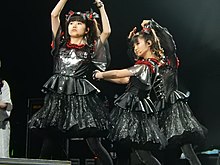Kawaii metal
| Kawaii metal | |
|---|---|
| Etymology | Kawaii |
| Other names |
|
| Stylistic origins |
|
| Cultural origins | Early 2010s, Japan |
| Subgenres | |
| Kawaiicore | |
| Other topics | |
Kawaii metal (also known as idol metal,[1] cute metal, J-pop metal, or kawaiicore[2]) is a musical genre that blends elements of heavy metal and J-pop that was pioneered in Japan in the early 2010s. The genre combines both Eastern and Western influences that appeal to both cultures.[3] A typical kawaii metal composition combines the instrumentation found in various types of heavy metal music with J-pop melodies and a Japanese idol aesthetic. Kawaii metal's lyrical topics often contain kawaii (cute, lovable, kidlike) themes.[4]
The Japanese girl group Babymetal is often credited with the creation and success of kawaii metal.
History and characteristics

Japanese
While discussing Babymetal, The Sydney Morning Herald's Rob Nash stated that the genre consisted of "sugary pop melodies over thrash metal". Nash also believed that the group's song "Awadama Fever" exemplified the genre, with its "slabs of angry guitar and undanceably fast breakbeats, while the girls [Babymetal] squeak about 'bubble ball fever' and chewing gum".[11]
Babymetal has remained extremely popular. In 2019, Babymetal became the first Asian artists to top Billboard’s Top Rock Albums chart, with their third studio album, Metal Galaxy.[12] Murray Stassen in Music Week commented that "Babymetal is, without a doubt, a genuine cross-genre musical phenomenon" and that, despite how the juxtaposition of metal and J-pop might not seem to make sense on paper: "[Babymetal has] proved that it can, and does work, and resistance to the Babymetal phenomenon is futile."[13]
Discussing Ladybeard, and Ladybaby, Jake Cleland of The Sydney Morning Herald defined the genre as "saccharine pop with his heavy metal
See also
References
- ^ a b Clay, Felix (27 May 2016). "7 Strange Aspects Of Japan's Pop Idol Metal Music Scene". Cracked.com. Retrieved 16 October 2016.
- ^ Ohanesian, Liz (15 October 2015). "Meet Ladybaby, Japan's Kawaiicore (and Pro-Wrestling) Answer to Andrew WK". Noisey. Retrieved 18 October 2016.
- ISBN 9781839099502. Retrieved 27 February 2021.
- ISBN 0-8248-2840-2. Retrieved 27 February 2021.
- Noisey. 15 July 2014. Retrieved 23 October 2016.
- ^ Cleek, Taylor (17 July 2015). "The Unpredictable Rise of Kawaiicore". Beyond the Stage. Retrieved 28 October 2016.
- ^ Rosenthal, Jeff (2014). "Babymetal: Gaga's Kooky Find". No. 24. Billboard.
- ISBN 9781839099502. Retrieved 27 February 2021.
- ^ Wallingford, Angelica (27 March 2014). "'Kawaii' metal goes viral". City Times. Retrieved 17 October 2016.
- ^ "Album Review: Babymetal's "Metal Resistance" is a Japanese metal mutant". The Independent. 21 May 2016. Retrieved 28 October 2016.
- ^ Nash, Rob (11 June 2016). "Babymetal: Japan's heavy metal girl-band sensation". The Sydney Morning Herald. Retrieved 28 October 2016.
- ^ Rolli, Bryan. "Babymetal Becomes First Asian Act To Top Billboard's Top Rock Albums Chart". Forbes. Retrieved 27 February 2021.
- ^ Stassen, Murray. "Music Periodicals Database". Music Week.
- ^ Cleland, Jake (11 July 2015). "From Ladybeard to Ladybaby: the pro wrestling heavy metal singer taking Japan by storm". The Sydney Morning Herald. Retrieved 17 October 2016.
- ^ Weiss, Alex (13 July 2016). "MEET THE JAPANESE GIRL GROUP GIVING METAL A KAWAII MAKEOVER". Paper. Retrieved 21 October 2016.
External links
- Tadano, John, and Yu, Yu. OSS! BABYMETAL on the way (English Edition) – listing on Amazon
- Babymetal: Metal Galaxy review – kawaii metal originators deliver clashy opus – newspaper article
- Babymetal – official website
- The Rise and Rise of Kawaii Metal – web article
- The Unpredictable Rise of Kawaiicore – magazine article
- Fruit Pochette – official website
